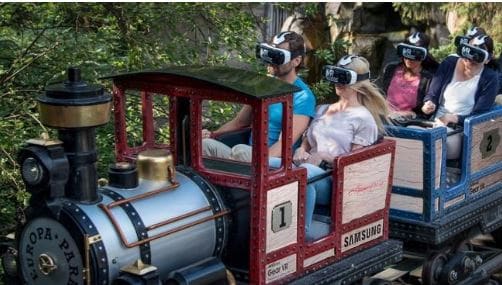By Ralph Witvoet 464927
Until last Saturday, my only experience with the application of Virtual Reality is depicted below. My farther came home from work and told me about an experience he had where he was given some sort of glasses and could walk over a plank. He shared with me how life-like he found it to be. This was very cool for me to hear, but to me, VR was an overhyped technology with countless of years to come before having any impact in the entertainment industry and I did not think this emerging technology could have an effect on how we work.

However, as my first sentence suggests, something changed. Last Saturday, some of my friends tricked me into going to a VR game centre in Rotterdam. Here I would fight off zombies using VR gear. I had little to none expectations, yet I was blown away. We had to put in our height and then we were given the VR glasses and guns and the game started. I could see my friends in our corresponding heights, I could see my gun and I was completely emerged in the world around me. It was so engaging and life-like that I ended up with terror-sweats. This completely changed my opinion about the state of development of the technology and I started to investigate VR.
VR impacting the Entertainment Industry
VR has long been evolved from a cool gimmick shown on business congresses. Now it is impacting various aspects of the entertainment industry (I am also including the cultural sector in this definition). An example of this is the establishment of VR leisure centres, which are entertainment centres purely built for VR games. Such centres have been founded in the last few years and are growing rapidly due to their success. However, VR is also impacting other types of entertainment. There are VR applications in theatres that help audiences immerse in virtual plays. Additionally, VR music concerts exists where VR lets you get in the skin of a music performer. There are VR experience centres on fair grounds and, moreover, VR theme parks exists. A picture of the aforementioned is depicted below.

Lastly, Museums have adopted VR practices to engage with audiences. VR lets audiences experience paintings on a whole new level, for example, by letting people see them up and close in solitude, showing the layers of which the painting is made up. It increases accessibility and makes exhibits come to life. Examples of museums using VR are The Louvre, the Peterson Automotive Museum and the Smithsonian.
VR is simultaneously creating different customer needs and fulfilling them. For the future, VR’s lifelike characteristics will increase creating a more seamless connection between movement and what is happening in the virtual world. Additionally, the shape of this virtual world will get better and better and it will become easier to have VR applications at home such as the Playstation VR there is now.
VR impacting working life
However, VR has impacted working life and will impact working life in the years to come in a substantial way that I did not realise.
On the one hand, VR technology has sparked the creation of virtual worlds, which businesses have adopted widely. By making use of 360° camera’s, business can create this virtual worlds, allowing customers to see, for example, how a restaurant looks from the inside, or in real estate how homes look. This creates value by giving customers more feel of the property.
On the other hand, actual VR glasses in business conducts show customers the end product. This application starts to emerge mainly in the construction industry, where architects and project developers show their vision. Customers can immediately see how the end-product will come to see.
What is also happening now on a small scale, is the use of VR in working remotely. In some companies, workers with special camera’s make recordings of products, e.g., a broken train, and then engineers with a VR glass, can see from home the problem and create the solution in this virtual world. The employees on sight can then follow these instructions, repairing the product. I think that this application will continue to evolve, impacting telecommuting and for example creating real-time virtual worlds, so experts all over the world can immediately come up with solutions to problems.
To conclude, I believe that the emerging VR technology will continue to develop, serving new customer needs and adding value to existing industries, such as the entertainment industry and the wider working industry like construction.
Sources:
Picture 1: https://uploadvr.com/richies-plank-quest-hand-tracking/
Picture 2: https://filmora.wondershare.com/virtual-reality/virtual-reality-use-in-entertainment.html
https://filmora.wondershare.com/virtual-reality/virtual-reality-use-in-entertainment.html
